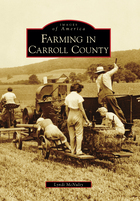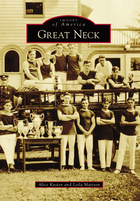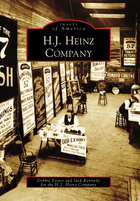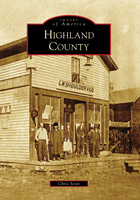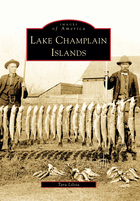Browse Titles - 155 results
3. The Business of Agriculture
written by Lyndi McNulty; in Farming in Carroll County, Images of America (Charleston, SC: Arcadia Publishing, 2009), 99-128
Carroll County’s road signs are a testament to the farm families who settled here. Bollinger, Hoff, Roop, Baugher, Royer, Bushey, and many more are road names that honor those who have produced food for themselves and the nation in times of peace, war, and the Great Depression. In 1917, when the first county agr...
Sample
written by Lyndi McNulty; in Farming in Carroll County, Images of America (Charleston, SC: Arcadia Publishing, 2009), 99-128
Description
Carroll County’s road signs are a testament to the farm families who settled here. Bollinger, Hoff, Roop, Baugher, Royer, Bushey, and many more are road names that honor those who have produced food for themselves and the nation in times of peace, war, and the Great Depression. In 1917, when the first county agricultural agent arrived, 96.6 percent of the land was held in 3,384 farms. By 1926, Carroll County, Maryland, led the state in corn, sw...
Carroll County’s road signs are a testament to the farm families who settled here. Bollinger, Hoff, Roop, Baugher, Royer, Bushey, and many more are road names that honor those who have produced food for themselves and the nation in times of peace, war, and the Great Depression. In 1917, when the first county agricultural agent arrived, 96.6 percent of the land was held in 3,384 farms. By 1926, Carroll County, Maryland, led the state in corn, swine, and poultry production. It was second in dairy and beef, and it was the world leader in wormseed oil production. A prominent feature of Carroll County’s landscape has always been the red barns, and they still are today. The photographs in this book were collected from farm families and historical organizations, portraying a unique insider’s view of the history of farm life in Carroll County.
Show more
Show less
Field of Study
American History
Content Type
Book
Author / Creator
Lyndi McNulty
Date Published / Released
2009
Publisher
Arcadia Publishing
Series
Images of America
Topic / Theme
Factories, Farming, Business, Fruits, Food industry, Meats and poultry, Industry
Copyright Message
Copyright © 2009 by Lyndi McNulty
×
2. Sugar City
written by Carol J. Coffelt St. Clair and Charles S. St. Clair; in Glendale, Images of America (Charleston, SC: Arcadia Publishing, 2006), 25-48
Established in 1892, nine miles northwest of Phoenix in the Salt River Valley of Arizona, Glendale at first attracted farmers with strong Protestant religious convictions. Soon, however, others began to settle in the town and on the rich farmlands of the area. Although predominantly Anglos, the settlers that came...
Sample
written by Carol J. Coffelt St. Clair and Charles S. St. Clair; in Glendale, Images of America (Charleston, SC: Arcadia Publishing, 2006), 25-48
Description
Established in 1892, nine miles northwest of Phoenix in the Salt River Valley of Arizona, Glendale at first attracted farmers with strong Protestant religious convictions. Soon, however, others began to settle in the town and on the rich farmlands of the area. Although predominantly Anglos, the settlers that came in the latter 1890s and early decades of the 1900s included various ethnic minorities. Each group had a significant role in the city's...
Established in 1892, nine miles northwest of Phoenix in the Salt River Valley of Arizona, Glendale at first attracted farmers with strong Protestant religious convictions. Soon, however, others began to settle in the town and on the rich farmlands of the area. Although predominantly Anglos, the settlers that came in the latter 1890s and early decades of the 1900s included various ethnic minorities. Each group had a significant role in the city's development into an important agricultural center that shipped produce all over the country. World War II and its influx of servicemen to train at Glendale's Luke and Thunderbird airfields brought permanent changes to Glendale. The population doubled and doubled again and again. Today the city-Arizona's fourth largest-is a metropolitan area of 59 square miles and close to 250,000 people. This volume offers windows to understanding the growth and development of Glendale over the years.
Show more
Show less
Field of Study
American History
Content Type
Book
Author / Creator
Carol J. Coffelt St. Clair, Charles S. St. Clair
Date Published / Released
2006
Publisher
Arcadia Publishing
Series
Images of America
Topic / Theme
Food industry, Crops
Copyright Message
Copyright © 2006 by Carol J. Coffelt St. Clair and Charles S. St. Clair
×
1. Mills and Farms
written by Alice Kasten and Leila Mattson; in Great Neck, Images of America (Charleston, SC: Arcadia Publishing), 9-18
Originally, Great Neck was a farming community on the North Shore of Long Island. For many years, this forested peninsula produced rich hay, fruit, and grain crops. As vacationers from Manhattan discovered the area, farms gave way to summer resorts and large estates. Well-known writers and actors such as F. Scott...
Sample
written by Alice Kasten and Leila Mattson; in Great Neck, Images of America (Charleston, SC: Arcadia Publishing), 9-18
Description
Originally, Great Neck was a farming community on the North Shore of Long Island. For many years, this forested peninsula produced rich hay, fruit, and grain crops. As vacationers from Manhattan discovered the area, farms gave way to summer resorts and large estates. Well-known writers and actors such as F. Scott Fitzgerald, Ring Lardner, and Groucho Marx were drawn to the area, as were many of the nation’s elite families like the Chryslers, Br...
Originally, Great Neck was a farming community on the North Shore of Long Island. For many years, this forested peninsula produced rich hay, fruit, and grain crops. As vacationers from Manhattan discovered the area, farms gave way to summer resorts and large estates. Well-known writers and actors such as F. Scott Fitzgerald, Ring Lardner, and Groucho Marx were drawn to the area, as were many of the nation’s elite families like the Chryslers, Brokaws, and Vanderbilts. Great Neck has homes designed by Frank Lloyd Wright and Gustav Stickley and a church with glorious Tiffany windows. A hub of suburban development, Great Neck has always been renowned for its excellent public schools, community-minded citizens, diverse population, parks, and cultural activities.
Show more
Show less
Field of Study
American History
Content Type
Book
Author / Creator
Alice Kasten, Leila Mattson
Publisher
Arcadia Publishing
Series
Images of America
Topic / Theme
Grist mills, Geophysical features, Farms
Copyright Message
Copyright © 2013 by Alice Kasten and Leila Mattson
×
Images of America, H. J. Heinz Company
in Images of America (Charleston, SC: Arcadia Publishing, 2006), 128 page(s),
Source: www.arcadiapublishing.com
Source: www.arcadiapublishing.com
In 1869, the American diet was a dreary affair. Kitchen staples included bread, potatoes, other root vegetables, and meat. Tomatoes–then called "love apples"–were an exotic fruit. A young 25-year-old Henry J. Heinz helped to change all of that. He established his company based on a single premise: quality. He...
Sample
in Images of America (Charleston, SC: Arcadia Publishing, 2006), 128 page(s),
Source: www.arcadiapublishing.com
Source: www.arcadiapublishing.com
Description
In 1869, the American diet was a dreary affair. Kitchen staples included bread, potatoes, other root vegetables, and meat. Tomatoes–then called "love apples"–were an exotic fruit. A young 25-year-old Henry J. Heinz helped to change all of that. He established his company based on a single premise: quality. He demonstrated this commitment by bottling his first product, grated horseradish, in clear glass jars to showcase its purity. From his ho...
In 1869, the American diet was a dreary affair. Kitchen staples included bread, potatoes, other root vegetables, and meat. Tomatoes–then called "love apples"–were an exotic fruit. A young 25-year-old Henry J. Heinz helped to change all of that. He established his company based on a single premise: quality. He demonstrated this commitment by bottling his first product, grated horseradish, in clear glass jars to showcase its purity. From his hometown near Pittsburgh, Heinz sparked a revolution. A colorful marketing genius, he was a foresighted entrepreneur whose peripatetic travels birthed the global H. J. Heinz Company, which today is the most international of all United States–based food companies. H. J. Heinz Company contains vintage images from the archives of one of America's first industrial photography studios. It captures memorable and creative marketing from the "57 Varieties" to today and features photography of many current initiatives in Heinz's main businesses of ketchup and sauces, meals and snacks, and infant foods. It is a glimpse at one of America's best loved companies and a study in how to "do the common thing uncommonly well."
Show more
Show less
Field of Study
American History
Content Type
Book
Date Published / Released
2006
Publisher
Arcadia Publishing
Series
Images of America
Topic / Theme
Food industry
Copyright Message
Copyright © 2006 by Debbie Foster and Jack Kennedy for the H. J. Heinz Company
×
3. Living Off the Land: Farming, Logging, and Maple Sugaring
written by Chris Scott; in Highland County, Images of America (Charleston, SC: Arcadia Publishing, 2007), 43-56
Named for its high altitude and boasting one of the smallest populations east of the Mississippi River, Highland County is nicknamed “Virginia’s Little Switzerland.” Although settlers began arriving in the area as early as 1745, Highland County was not officially formed until 1847. Portions were carved from...
Sample
written by Chris Scott; in Highland County, Images of America (Charleston, SC: Arcadia Publishing, 2007), 43-56
Description
Named for its high altitude and boasting one of the smallest populations east of the Mississippi River, Highland County is nicknamed “Virginia’s Little Switzerland.” Although settlers began arriving in the area as early as 1745, Highland County was not officially formed until 1847. Portions were carved from neighboring Bath and Pendleton Counties to create the new county of Highland. The isolation of the area required great perseverance and...
Named for its high altitude and boasting one of the smallest populations east of the Mississippi River, Highland County is nicknamed “Virginia’s Little Switzerland.” Although settlers began arriving in the area as early as 1745, Highland County was not officially formed until 1847. Portions were carved from neighboring Bath and Pendleton Counties to create the new county of Highland. The isolation of the area required great perseverance and commitment from the early German and Scotch Irish settlers, but in many ways, it gave the area its identity and character. Highland County has a rich tradition of both strong individualism and community spirit. With photographs from the 19th and 20th centuries and into the new millennium, this volume tells the rich, fascinating story, both rural and modern, of the county and its people.
Show more
Show less
Field of Study
American History
Content Type
Book
Author / Creator
Chris Scott
Date Published / Released
2007
Publisher
Arcadia Publishing
Series
Images of America
Topic / Theme
Farming, Logging, Food industry
Copyright Message
Copyright © 2008 by Chris Scott
×
3. High Cotton Returns
written by Ann Dunphy Becker; in Houston: 1860 to 1900, Images of America (Charleston, SC: Arcadia Publishing, 2010), 61-100
In an area that was little more than a thick forest lining Buffalo Bayou, Houston was founded in 1836 by the Allen brothers and named after the Republic of Texas's beloved general Sam Houston. By 1860, there were 5,000 residents in Houston, wooden sidewalks, a few shell-paved roads, and five railroads. Out of the...
Sample
written by Ann Dunphy Becker; in Houston: 1860 to 1900, Images of America (Charleston, SC: Arcadia Publishing, 2010), 61-100
Description
In an area that was little more than a thick forest lining Buffalo Bayou, Houston was founded in 1836 by the Allen brothers and named after the Republic of Texas's beloved general Sam Houston. By 1860, there were 5,000 residents in Houston, wooden sidewalks, a few shell-paved roads, and five railroads. Out of the mud and mayhem of Houston's humble frontier beginnings arose men like Thomas W. House, Alexander P. Root, Edward Hopkins Cushing, Thoma...
In an area that was little more than a thick forest lining Buffalo Bayou, Houston was founded in 1836 by the Allen brothers and named after the Republic of Texas's beloved general Sam Houston. By 1860, there were 5,000 residents in Houston, wooden sidewalks, a few shell-paved roads, and five railroads. Out of the mud and mayhem of Houston's humble frontier beginnings arose men like Thomas W. House, Alexander P. Root, Edward Hopkins Cushing, Thomas Bagby, and William S. Swilley. The sleepy little bayou that wound from Main Street and emptied into Galveston Bay would soon become one of the largest ports in the south. By 1900, the founders' grandchildren were ready to strike out on their own and would play their part in building a great Texas city, a railroad nexus for the Gulf Coast, and an international port of call.
Show more
Show less
Field of Study
American History
Content Type
Book
Author / Creator
Ann Dunphy Becker
Date Published / Released
2010
Publisher
Arcadia Publishing
Series
Images of America
Topic / Theme
Cotton, Factories, Cotton mills, Farming, Cemeteries, Food industry, Steamboats, Bridges, Houses, Persons, Buildings
Copyright Message
Copyright © 2010 by Ann Dunphy Becker
×
2. Milk and Farming
written by Nancy S. Bacheller; in Huntley, Images of America (Charleston, SC: Arcadia Publishing, 2009), 17-36
Huntley was founded in 1851. Its first boom years—the 1850s to 1920s—saw the town prosper thanks to the local dairy industry. Prolific dairy farmers provided milk for the many local condensing plants and cheese factories and sent huge surpluses into Chicago by train each day. It was said that the Huntley area...
Sample
written by Nancy S. Bacheller; in Huntley, Images of America (Charleston, SC: Arcadia Publishing, 2009), 17-36
Description
Huntley was founded in 1851. Its first boom years—the 1850s to 1920s—saw the town prosper thanks to the local dairy industry. Prolific dairy farmers provided milk for the many local condensing plants and cheese factories and sent huge surpluses into Chicago by train each day. It was said that the Huntley area produced more milk per square mile than anywhere else in the world. Businesses, homes, and churches all grew with the population. Villa...
Huntley was founded in 1851. Its first boom years—the 1850s to 1920s—saw the town prosper thanks to the local dairy industry. Prolific dairy farmers provided milk for the many local condensing plants and cheese factories and sent huge surpluses into Chicago by train each day. It was said that the Huntley area produced more milk per square mile than anywhere else in the world. Businesses, homes, and churches all grew with the population. Village founders, movers and shakers of a century and more ago, as well as everyday workers and village residents are captured here in vintage images, showing what life was like in Huntley in years gone by.
Show more
Show less
Field of Study
American History
Content Type
Book
Author / Creator
Nancy S. Bacheller
Date Published / Released
2009
Publisher
Arcadia Publishing
Series
Images of America
Topic / Theme
Factories, Family farms, Dairy products, Farming, Food industry, Farms, Persons
Copyright Message
Copyright © 2009 by Nancy S. Bacheller
×
2. Waterpower Brings Industry
Once known as the Kuyahoora River, the West Canada Creek flows from the southern Adirondacks into the Mohawk River at Herkimer. Kuyahoora Towns provides a snapshot view of the early days in the Kuyahoora's four valley and upland towns: Fairfield, Newport, Norway, and Russia. It further explores the villages and su...
Sample
Description
Once known as the Kuyahoora River, the West Canada Creek flows from the southern Adirondacks into the Mohawk River at Herkimer. Kuyahoora Towns provides a snapshot view of the early days in the Kuyahoora's four valley and upland towns: Fairfield, Newport, Norway, and Russia. It further explores the villages and surrounding countryside of Fairfield, Norway, Gray, Cold Brook, Russia, Poland, Gravesville, Newport, and Middleville. The book highlight...
Once known as the Kuyahoora River, the West Canada Creek flows from the southern Adirondacks into the Mohawk River at Herkimer. Kuyahoora Towns provides a snapshot view of the early days in the Kuyahoora's four valley and upland towns: Fairfield, Newport, Norway, and Russia. It further explores the villages and surrounding countryside of Fairfield, Norway, Gray, Cold Brook, Russia, Poland, Gravesville, Newport, and Middleville. The book highlights the cheese industry, Fairfield Academy with its medical college, the invention of the Yale Lock, and the area's beautiful limestone bridges, homes, and churches.
Show more
Show less
Field of Study
American History
Content Type
Book
Date Published / Released
2003
Publisher
Arcadia Publishing
Series
Images of America
Topic / Theme
Dairy products, Factories, Food industry, Grist mills, Lumber mills, Textile mills, Manufactured material, Industry
Copyright Message
Copyright © 2003 by Kuyahoora Valley Historical Society
×
6. Agriculture: Orchards and Dairy Farms
written by Tara Liloia; in Lake Champlain Islands, Images of America (Charleston, SC: Arcadia Publishing, 2009), 63-72
On July 3, 1609, French explorer Samuel de Champlain and his group canoed south from Canada into an expansive lake and found four islands. Those islands are now the Lake Champlain Islands, and it was that trip that gave birth to Vermont and sparked 400 years of history. Located in the far northwest corner of the s...
Sample
written by Tara Liloia; in Lake Champlain Islands, Images of America (Charleston, SC: Arcadia Publishing, 2009), 63-72
Description
On July 3, 1609, French explorer Samuel de Champlain and his group canoed south from Canada into an expansive lake and found four islands. Those islands are now the Lake Champlain Islands, and it was that trip that gave birth to Vermont and sparked 400 years of history. Located in the far northwest corner of the state, the islands are well known as a shoreline retreat for all of New England, with their small-town feel and picturesque farmlands. I...
On July 3, 1609, French explorer Samuel de Champlain and his group canoed south from Canada into an expansive lake and found four islands. Those islands are now the Lake Champlain Islands, and it was that trip that gave birth to Vermont and sparked 400 years of history. Located in the far northwest corner of the state, the islands are well known as a shoreline retreat for all of New England, with their small-town feel and picturesque farmlands. In this birthplace of Vermont, with its rich soil, early settlers found success growing local varieties of apples, which they shipped by steamboat directly to international cities. Several large deposits of unique, dark limestone brought marble trade to the area, and these materials are still mined in working quarries today. The Lake Champlain Islands are a tranquil, yet vibrant area of Vermont, where historical buildings are often used as schools, museums, libraries, and private homes.
Show more
Show less
Field of Study
American History
Content Type
Book
Author / Creator
Tara Liloia
Date Published / Released
2009
Publisher
Arcadia Publishing
Series
Images of America
Topic / Theme
Islands, Food industry, Fruits, Orchards and groves
Copyright Message
Copyright © 2009 by Tara Liloia
×
5. The Jell-O Story
written by Lynne J. Belluscio; in LeRoy, Images of America (Charleston, SC: Arcadia Publishing), 71-80
LeRoy is best known as the "Birthplace of Jell-O," but few people know that in 1929 it had one of the finest private airports in the United States and was home to Amelia Earhart's airplane, the Friendship. In the 19th century, LeRoy was known for Igham University, one of the first colleges for women and the first...
Sample
written by Lynne J. Belluscio; in LeRoy, Images of America (Charleston, SC: Arcadia Publishing), 71-80
Description
LeRoy is best known as the "Birthplace of Jell-O," but few people know that in 1929 it had one of the finest private airports in the United States and was home to Amelia Earhart's airplane, the Friendship. In the 19th century, LeRoy was known for Igham University, one of the first colleges for women and the first to grant a four-year degree. First settled in 1797, LeRoy has produced patent medicines, salt, limestone, dynamite, plows, agricultural...
LeRoy is best known as the "Birthplace of Jell-O," but few people know that in 1929 it had one of the finest private airports in the United States and was home to Amelia Earhart's airplane, the Friendship. In the 19th century, LeRoy was known for Igham University, one of the first colleges for women and the first to grant a four-year degree. First settled in 1797, LeRoy has produced patent medicines, salt, limestone, dynamite, plows, agricultural commodities, stoves, organs, insulators, and a myriad of other products. Located on the eastern edge of Genesee County and 30 miles southwest of Rochester, LeRoy originally depended on water power from the Oatka Creek and was soon serviced by several railroads. It was also a station on the Underground Railroad.
Show more
Show less
Field of Study
American History
Content Type
Book
Author / Creator
Lynne J. Belluscio
Publisher
Arcadia Publishing
Series
Images of America
Topic / Theme
Food industry
Copyright Message
Copyright © 2010 by Lynne J. Belluscio
×

